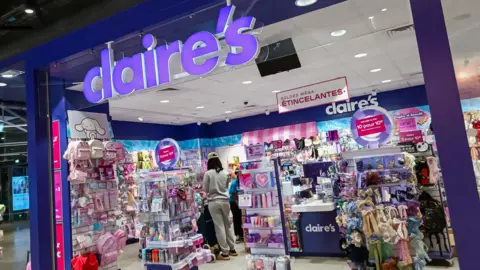Claire’s, a popular fashion accessories chain known for its vibrant and colorful offerings, has filed for bankruptcy in the United States for the second time. This decision comes amid increasing competition from online retailers and a notable decline in foot traffic to physical stores. The bankruptcy filing, made public recently, has raised concerns regarding the company’s future, especially as it battles with the evolving retail landscape where consumer buying behavior has shifted prominently towards digital platforms.
The company announced that it has already begun discussions with various partners to explore potential avenues for recovery and maintain operations. Specifically, Claire’s stated that it is engaging with its vendors and landlords regarding its North American retail locations. Despite the bankruptcy filing, Claire’s intends to keep its stores open while evaluating “alternatives” for restructuring its business, assuring that there will be no immediate negative impact on their UK outlets. Currently, the fashion staple operates approximately 2,750 stores across 17 countries, including the UK, where it has around 280 locations.
This is not the first time Claire’s has faced such significant challenges. The firm initially filed for bankruptcy protection in 2018 due to the inability to meet debt obligations, largely attributed to a $500 million loan due in December 2024. The company has struggled to keep pace with shifting shopping trends, especially as younger consumers turn to online marketplaces for accessories at significantly lower prices. Competition from brands like Shein, which specializes in cheap, trendy apparel and accessories, has significantly impacted Claire’s sales and foot traffic.
Claire’s CEO, Chris Cramer, expressed that the decision to file for bankruptcy was tough yet necessary. In his statement, he highlighted several contributing factors – rising competition, a decline in consumer spending on traditional retail, and a mounting burden from debt obligations. Cramer pointed out that the ongoing shift away from physical shopping experiences has also played a crucial role in the company’s fiscal trouble, emphasizing the wider economic issues affecting consumer behavior, including tariffs imposed during the ongoing trade tensions between the U.S. and other countries, particularly China and Canada.
Retail analyst Julie Palmer emphasized that Claire’s reliance on physical storefronts, once a hallmark of its brand, has turned into a significant liability in the current shopping environment. Retail experts like Catherine Shuttleworth have noted that many shoppers, especially the younger demographic, are now more inclined to discover brands via platforms such as TikTok, rather than visiting shopping centers. This change in consumer habits has exacerbated the plight of traditional retailers like Claire’s.
Despite these difficulties, Claire’s holds a number of franchised stores beyond its flagship markets, particularly in the Middle East and South Africa, and maintains a presence in many concessions across Europe and North America. Established in the 1990s, Claire’s has been a staple shopping destination for tweens and their families, offering an array of products ranging from jewelry to accessories like hair clips, and even toys.
However, the rapid evolution of the retail sector poses a pressing question for Claire’s regarding its future. Its traditional offerings and business practices may need to be redefined to survive and thrive in a competitive environment where online shopping continues to dominate. The ongoing restructuring discussions will be closely watched by industry observers, as they will determine not only the fate of Claire’s but also reflect broader trends that could signal the future trajectory of retail in a post-pandemic world.
In conclusion, Claire’s bankruptcy filing presents a crucial moment for the firm, one that underscores the challenges facing many brick-and-mortar retailers today. As the company navigates through this turbulent period, it remains to be seen whether it can adapt effectively to the changing retail landscape or if it, like many before it, will fall victim to the shifting tides of consumer preferences and market dynamics.











